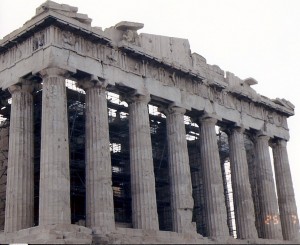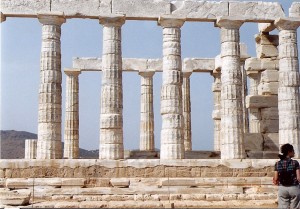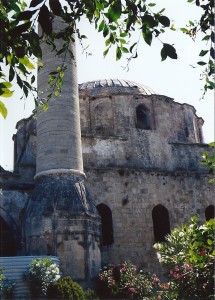
The Central Market near Omonia
This morning in the dining room where we have breakfast in the hotel, I made a cup of Greek coffee for a gentleman from Germany. The hotel provides us with a hot plate. On top of it is a metal box made filled with sand. The hot plate heats the sand which heats the water in the briki. The little brass pot is filled with water, and then coffee and sugar if desired, stirred, and placed on the sand. After several minutes, the coffee foams to the top and you then pour it into little cups. He didn’t know how to do it, so I did it for him as he watched. He asked where I was from and I said Pittsburgh.
“Have you heard of it?”
“Yes, they make steel there.”
“Well,” I said, “not any more. We make technology now.”
He knew a lot about Premier Simitis of Greece and I assume, the rest of Europe, but wasn’t up to date about the US. I thought he wanted to engage me in a discussion about President Bush and/or American foreign policy but refrained.
I promised Andrea that after this we would not climb any more mountains nor walk any more dusty, rocky paths. For the remainder of our trip we did not.
Where else but in Greece do you run into people you know? (Actually, I have friend who runs into people everywhere: Israel, Canada, New York, etc., but I never do.)
We decided to look at the market which is near our hotel. (It is similar to the Strip District in Pittsburgh.) The meat and fish vendors display the heads of
pigs, pig’s feet, the intestines and the whole lamb, cow, or pig. They also call out to customers to buy their wares and offer excellent prices (according to them.)
Andrea posed with one vendor and I will mail the photo to him. At first, she was “grossed out” at the sight of all this but after a while she took pictures of everything. The other vendors in the central market sell hats, underwear, fans, beach towels, shoes, pets, you name it. There is a Marks and Spenser in the neighborhood. I hadn’t been in one since I was last in England. I had to go in and look around.
The prices of clothes in the stores (other than in the central market) are a little higher that we are used to here but they have good sales.
There are also gypsies in Greece who always peddlling something. At the taverna in Monastiraki, they were either selling (Kleenex) tissue or playing music to the patrons. Gypsies are not shy about putting their children to work.
Andrea and I ran into a rest room in a coffee shop. One of the patrons overheard me speaking to her in Greek and struck up a conversation with me. When she found out we were from America, she…guess what??????? No, she didn’t tell me to go home or drop dead. She said she loved America and Americans and has been there many times Chicago, San Francisco, and I think she mentioned Detroit, too. She has friends and family who live there and she misses them. She is fearful of traveling post Sept. 11 the. She treated us to coffee and ice cream in a coffee shop in the central market and we exchanged telephone numbers. I told her to visit me in Pittsburgh the next time she comes to the US. She was very nice and we talked like old friends.
Later that evening we went back tot the Plaka with another koumbara and her daughter, Athena(not connected to the koumbari who are holding the wedding), and we ran into some of the friends we saw at the Acropolis plus some we had seen at the taverna, etc. It’s a small world. Elpi, Papou, and Christopher, I was informed were at the church in the town square but I couldn’t find them. It turned out later that they were looking for me, too. (Mike didn’t last long and headed back to the hotel and the Internet Cafe.)
The Plaka was packed with gypsies, tourists, and vendors. Andrea and Athena loved the vendors who let them play with their wares. As we were leaving, we ran into our friends again (but not Elpi, Chris or Papou) and we also saw the bride with them. Her name is also Elpi.
Our priest, Father Serviou, told us about a jeweler, a friend of his from his university days, who gave us great discounts. He will be in the States next winter, he informed us, because his son is marrying a woman from Ohio. He also told Chrissie how to get to Portorafti where she is staying with a cousin. The bus connections to that town are limited in the evenings but he told her to take the airport bus to the airport and catch a cab from there. Portorafti is right by the El.Venizelos Airport. He was very friendly and served us drinks, too.
We ran into an American tourist who had walked from her hotel to the Plaka and couldn’t find her way out. I wasn’t sure how to help her.
“Do you speak Greek?” I asked.
“No.”
So we went into the nearest shop and I asked the way back to the Temple of Zeus (which was across the street from her hotel). One of the workers was African but spoke excellent Greek. Like most Greeks, he gave general directions which get you lost.
“I have an extra Metro ticket,” I said. “Follow us. Chrissie and Athena are getting off at Syntagma Square and that will bring you a few blocks from your hotel.”
I made another friend that night. Her name was Rose Marie. She was touring Greece with a group and was from California. The next day she was to go up Mount Lycabettus.
“I understand the vehicular is being repaired,” she commented.
“Ain’t no vehicular unless it is invisible,” I said. I mentioned how we couldn’t find it but I found out later that the lift at least used to exist. She laughed.
What was scary to me was that I was learning the streets of Athens. I found Byron Street which was where the Metro station was and I even knew which line to take when we descended into the Metro. When we got off I told her to take a right and at her hotel was only a couple of blocks on her right. I wonder if I will remember these streets the next time I’m in Athens.
Well, Chrissie and Athena hopped on the airport bus and Andrea and I walked home. It was quite late. We always walked late in the evening but I never
feared for our safety. Athens is supposed to have the lowest crime rate of any European city but I think I instinctively felt safe.
The next day, I went to the Benaki Museum on Queen Sophia Avenue. I went alone while Mike and Andrea went looking for the Children’s Museum. I passed the beautiful Embassy of Egypt and I literally stared at the building.
“An old man made a comment about tourists and I replied to him in Greek, “Yes, I am. So what?” He shuffled away clicking his worry beads.
The Benakeion (emphasis on the “na”) is housed in a lovely old building which you can’t find because the sign is on the gate facing the side street and is only about 14″ by 17″. When you finally do find, it doesn’t disappoint. It houses ancient jewelry, statues, and pottery from ancient Greece and Cyprus as well as a very extensive collection of Byzantine Art. What wowed me, though, was the collection of folk costumes from the period after Byzantium and up to the War of Independence. There is furniture, jewelry, ceramics, textiles (I value the textiles I inherited even more than I did before) from Greece and Cyprus. There are drawings and watercolors of Greece made by European “visitors.” It is a vast and well maintained collection and the Benaki deserves its reputation.
At one point I was staring at an icon and I could hear a voice saying in English, “Yes, I can make it then. I will meet you.” I looked around but I was the only person I could see in the gallery. I knew it couldn’t be the icon.
“Yes, of course. So long, Father,” he said in Greek. I suddenly realized that this person was standing behind the wall the icon hung from. I ran into the next room as soon as he said good-bye because I didn’t want him to think I was eavesdropping.
That night we went to Vouliagmeni for Elpi and Dean’s wedding. It is a small, lovely white church – like a country church surrounded by trees, flowers and a stone wall. The guests stood around because a baptism was being conducted prior to the wedding. The groom stood waiting for the bride (and the baptism to end). He held a bouquet of yellow roses because tradition dictates that he meet the bride outside the church, give her a kiss and the bouquet.
She arrived fashionably late with her father (but not too late because priests in Greece are extra busy in the summer). The groom kissed her on the cheek, gave her the bouquet and they entered the church. Their parents followed including the maid of honor and the best man. They’re both the koumbari, the person(s) who exchange the crowns and the rings in an Orthodox Christian service. The three little Myrofori followed. They were dressed in white. Their ages range from 5 to 10 and they are like little junior bridesmaids. (They were her goddaughter, Zoe, her niece, Alexandra, and her cousin from Cyprus, Myrto.) Then, the guests rushed into the little church and stuffed themselves into the pews. Everyone tried to form a circle around the bride and groom but some of us didn’t make it past the pews or the center aisle. Mike left and stood outside as so many of the other guests were forced to do. He said he has seen it before anyway (like when we got married).
The rush of people out of the church was like the rush of people into it. As Elpi (Andrea’s godmother, not the bride) and I were saying, “You can’t take the villager out of them.”
Rented buses took us to the Island Club. It is situated by a bay. The wedding was at 7 and so the reception was in the evening. The moon was almost full and very white against a dark sky. The Med washed against the rocks by the shore and in the distance the land was illuminated with white lights. There was a small white chapel near the reception area with a path that led to the stone wall at the edge of the property. An outcropping of rock jutted into the bay on the left. The wedding was, visually, the most beautiful I have ever seen, from the church service to the reception.
It was also one of the most enjoyable. The guests had a rollicking good time. The guests came from Greece (the groom’s relatives), Cyprus (the bride’s relatives) and Ohio and Pennsylvania (the rest of their relatives.) One family came from England.
The food was bountiful and included sheftelies (Cypriot sausages for those of you who may not know) and plenty to drink. We all danced including
Mike who doesn’t usually dance Greek dances. My feet hurt for days afterward.
A note to those of you who saw MY BIG FAT GREEK WEDDING, the Cypriots are the epitome of the Greeks in the movie. Regardless of the seating arrangement, the men sat at one table and the women sat at another. There was much singing as well as dancing. Everyone had a ball but I think they had more of a ball than anyone.
The wedding was a great finale to a great trip.
Thanks for reading my long story (those of you who lasted.)







